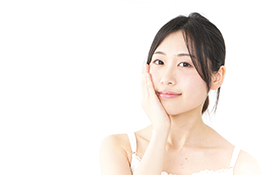Veins are blood vessels that carry blood from your body's tissues to your heart. Veins have one-way valves that help keep blood flowing toward your heart. If your valves are weak or damaged, blood can back up and pool in your veins. This causes the veins to swell, which can lead to varicose or spider veins.
Typically, we think of this swelling occurring in the legs. However, varicose and spider veins can appear on your face, your breasts, as well as, your hands. While the underlying causes may be similar for each part of your body, the treatment for each area can vary.
Here’s a look at some of those treatments:
Veins on the Face
Spider veins on the face can form around the nose, on the cheeks, and the chin. In these areas, we find the best treatment is with laser therapy. This treatment works to lighten the veins and blend them into surrounding skin.
Some people have prominent veins around the eyes and on the forehead, which are too large for laser therapy. Sclerotherapy injections would be the next treatment route, but since the solution cannot be used around the eyes, we would refer you to a plastic or oculoplastic surgeon. These skilled specialists, who are trained in all areas of eyes and eyelids, use local anesthesia and remove the veins surgically.
The veins on the sides of the face that run down to the neck can be effectively and safely treated with sclerotherapy.
Some of the causes for veins on the face, include:
- Genes: People whose family members experience spider veins are more likely to have them, too.
- Sun exposure: Sun damage can enlarge the blood vessels and draw them closer to the skin.
- Changes in weather: Drastic changes in the weather may affect the circulation in the body, causing the skin in the face to flush. The blood vessels may burst, causing a spider vein.
- Changes in pressure: Sudden, extreme changes in pressure may cause small broken blood vessels to appear. An exceptionally hard sneeze or vomiting can cause this change in pressure.
- Pregnancy: Hormonal changes during pregnancy may also cause broken blood vessels. Pregnancy-related spider veins usually disappear after giving birth.
- Environmental irritants: Exposure to certain chemicals or environmental pollutants may damage the skin and make blood vessels more visible.
- Rosacea: This is a common condition that causes the skin to become flushed and red due to enlarged veins. People with rosacea often experience spider veins.
- Alcohol consumption: Alcohol can dilate the blood vessels temporarily. Frequent alcohol consumption may lead to longer-lasting broken blood vessels and redness on the face.
Veins on the Breast
Blue veins are a common occurrence and can appear on your breasts for many reasons.
- Youth and Genetics:These veins can appear when you’re young, especially if you have a genetic pre-disposition to “veiny” skin.
- Pregnancy:They can develop during and after pregnancy when breasts begin to prepare for nursing.
- Surgery and Cancer:They may also appear after breast implant or reconstructive surgery. Cancer survivors who’ve made it through their surgery and radiation might not want to see blue-veined reminders of their ordeal.
- Age:The simple fact of aging can deposit blue veins in your breasts, along with a smattering of broken capillaries and spider veins.
There are various methods of safe and effective treatment, such as Sclerotherapy, which we perform at our vein centers. This treatment is targeted to the breast area and conducted with the utmost care--always keeping your health and safety in mind.
Veins on the Hands
With blue and bulging veins beginning to appear on the back of your hands, you may feel this look adds years to your age. As you age, you naturally lose skin elasticity and subcutaneous fatty tissue in the backs of your hands, and thus, you also lose water content in your hand tissue. The ‘thinning out’ of your previously pink and youthful hands has revealed the highway of veins beneath the surface. You might also have a genetic pre-disposition to veiny hands, which can make matters even more prominent.
Prominent veins of the hands are best treated with phlebectomies, which involves the surgical removal of the vein using local anesthesia in the office. The results are very gratifying for our patients. Occasionally, it is possible to treat some of these veins with sclerotherapy injections.
But to best know the type of treatment that will work for you, talk to one of our Vein Institute of NJ board-certified physicians today. They will provide an in-depth consult to better understand your existing medical conditions and family history, and then determine the right course of treatment. Just think how close you are to achieving a more youthful and healthy-looking face, breasts and hands.








.jpg?width=944&name=Castle-Connolly-Top-Doctors-Emblem-Large%20(4).jpg)